Abstract
The ability of transcutaneous recordings of gastric electrical activity to detect gastric electrical abnormalities was determined by simultaneous measurements of gastric electrical activity with surgically implanted serosal electrodes and cutaneous electrodes in six patients undergoing abdominal operations. Transient abnormalities in gastric electrical activity were seen in five of the six patients during the postoperative period. Recognition of normal gastric electrical activity by visual analysis was possible 67% of the time and with computer analysis 95% of the time. Ninety four per cent of abnormalities in frequency were detected by visual analysis and 93.7% by computer analysis. Abnormalities involving a loss of coupling, however, were not recognised by transcutaneous recordings. Transcutaneous recordings of gastric electrical activity assessed by computer analysis can usually recognise normal gastric electrical activity and tachygastria. Current techniques, however, are unable to detect abnormalities in electrical coupling.
Full text
PDF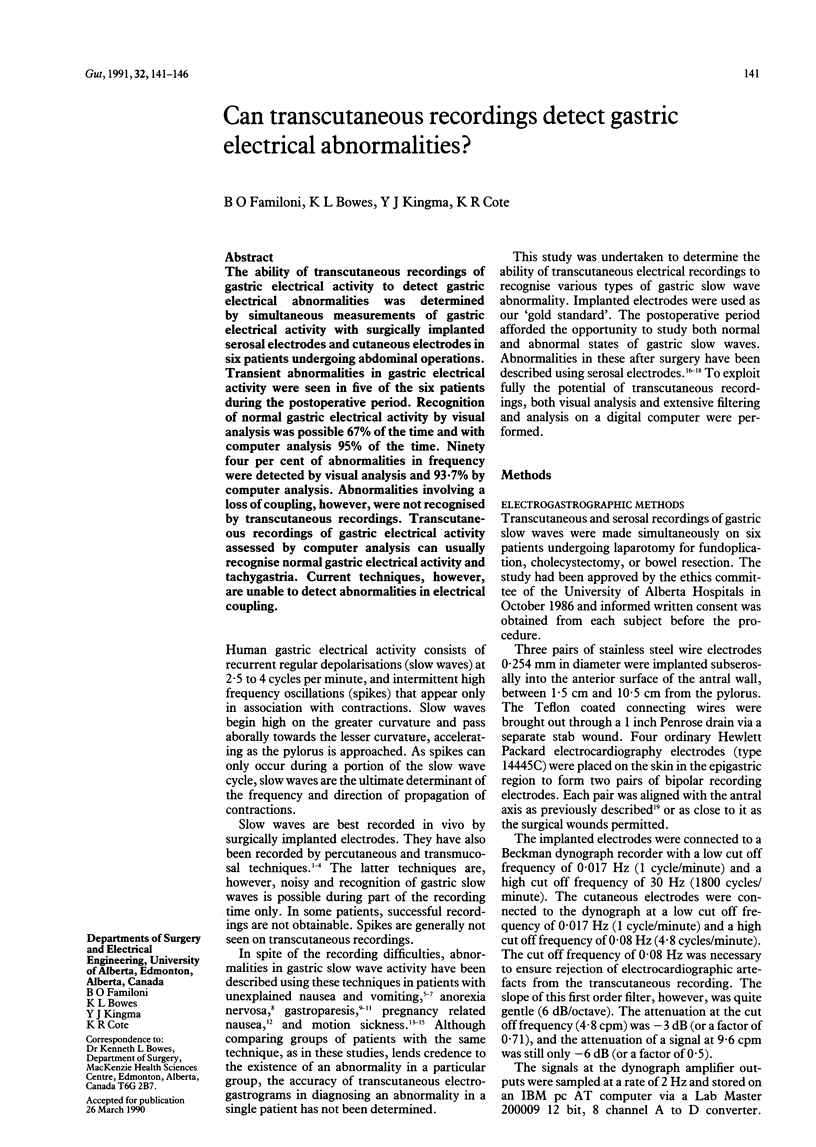
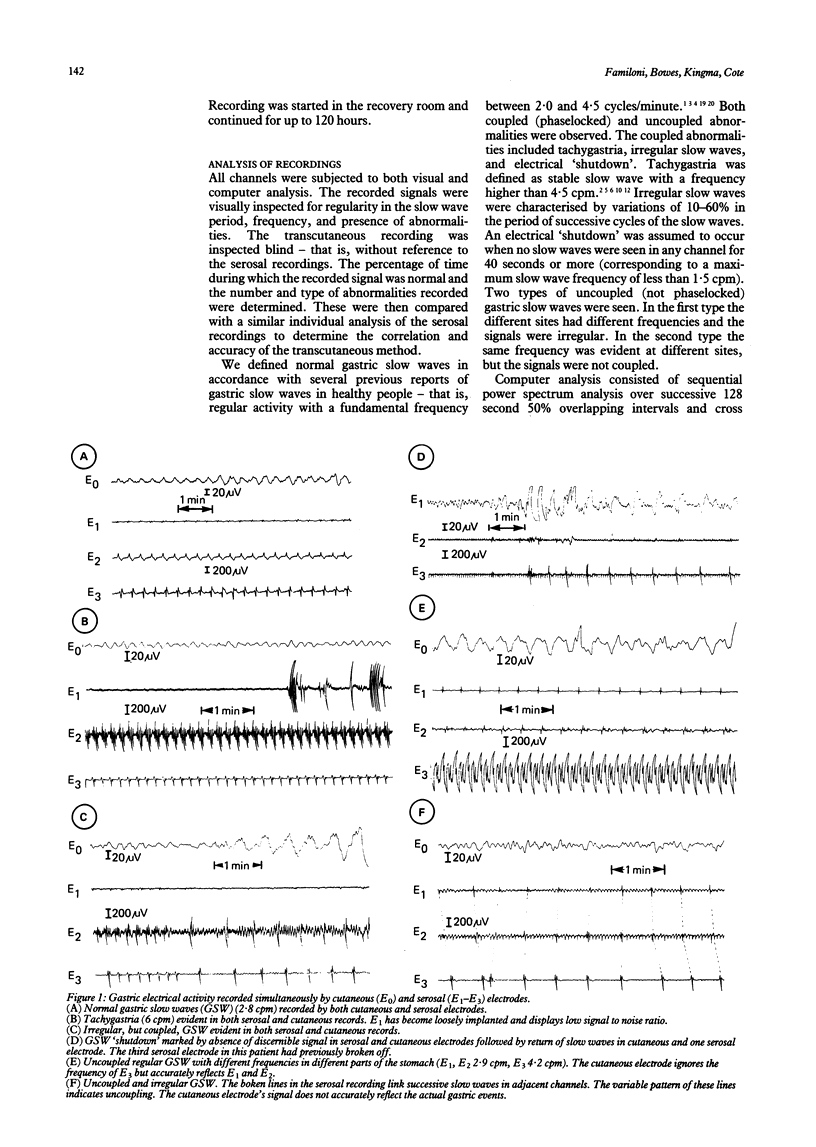
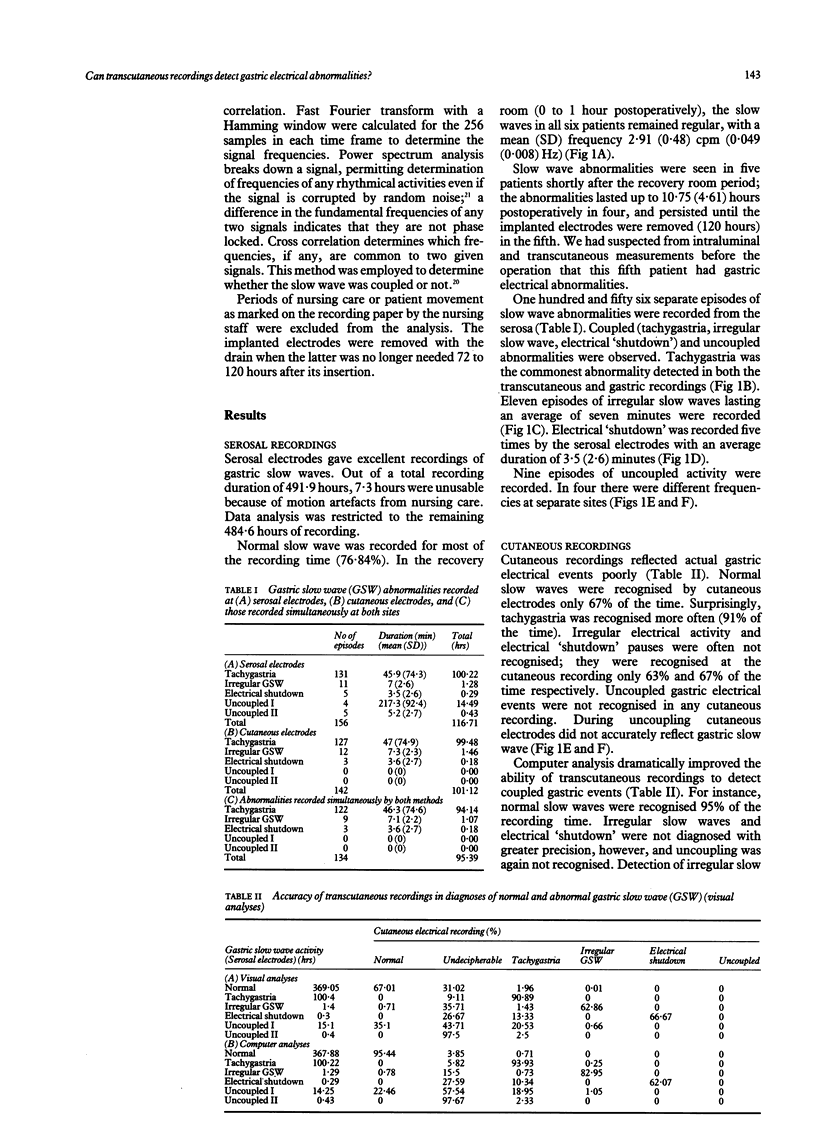
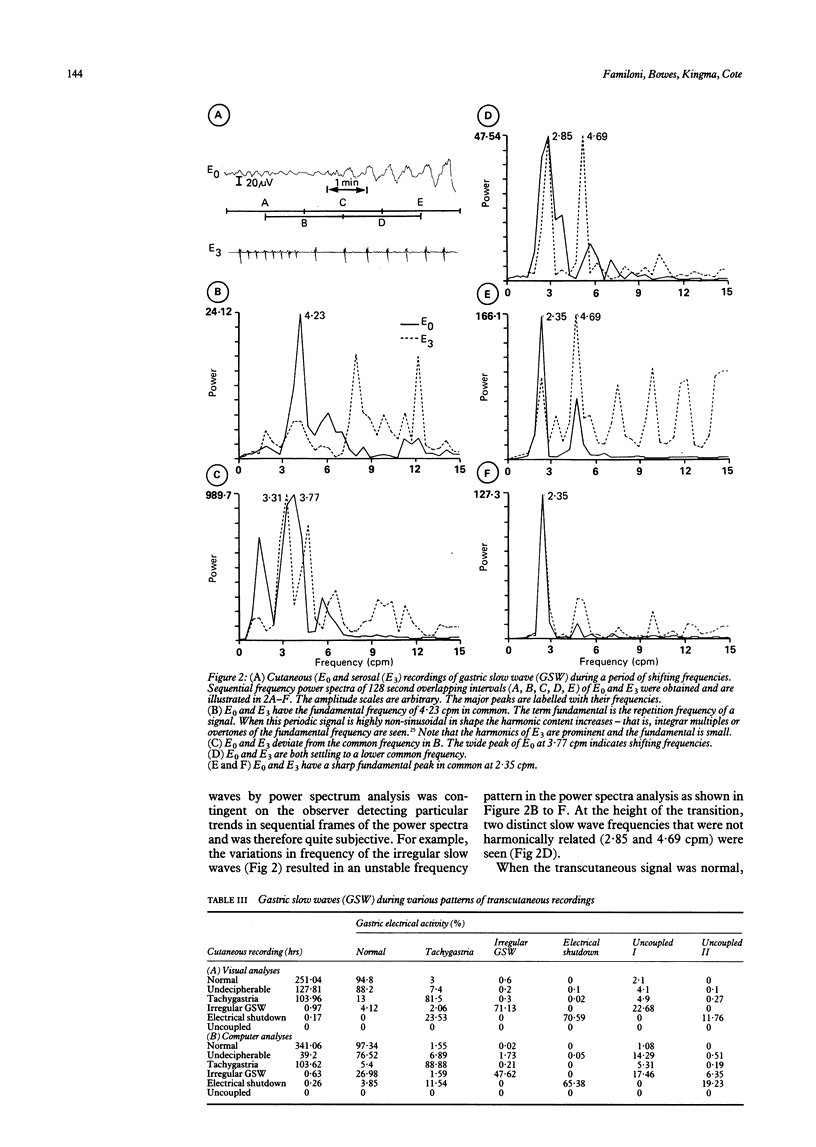
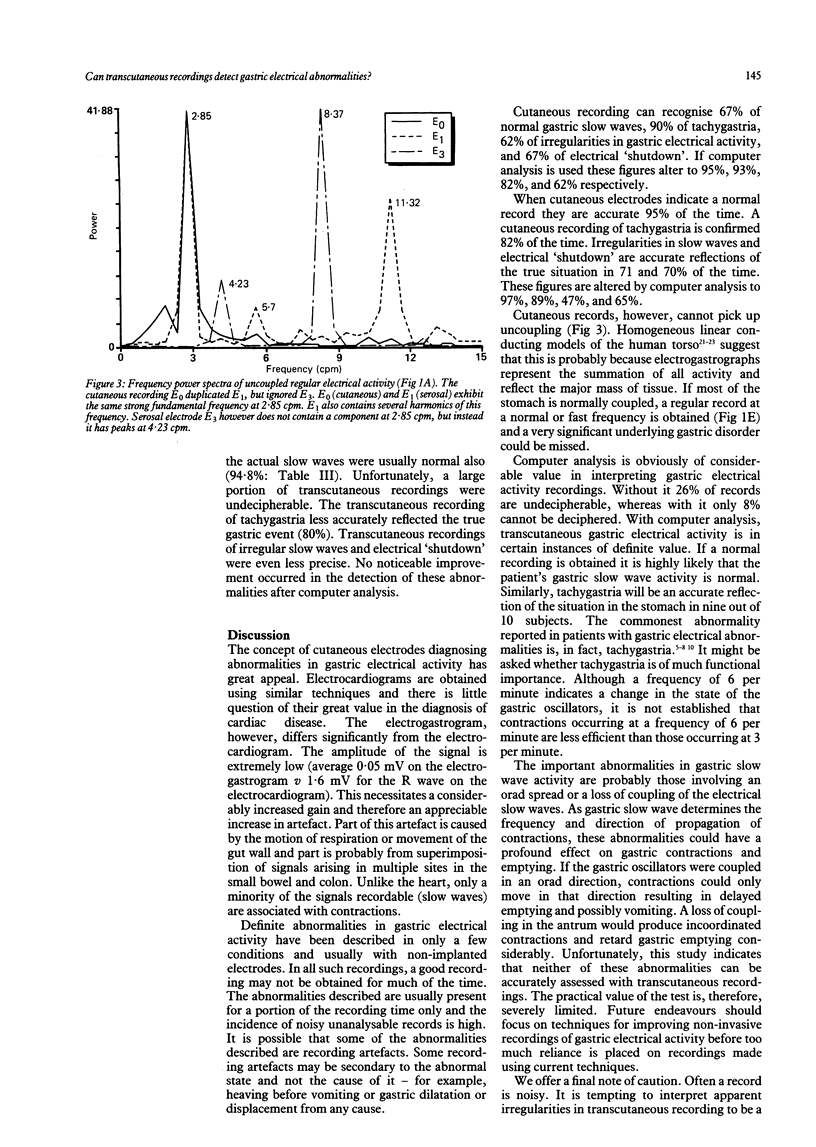
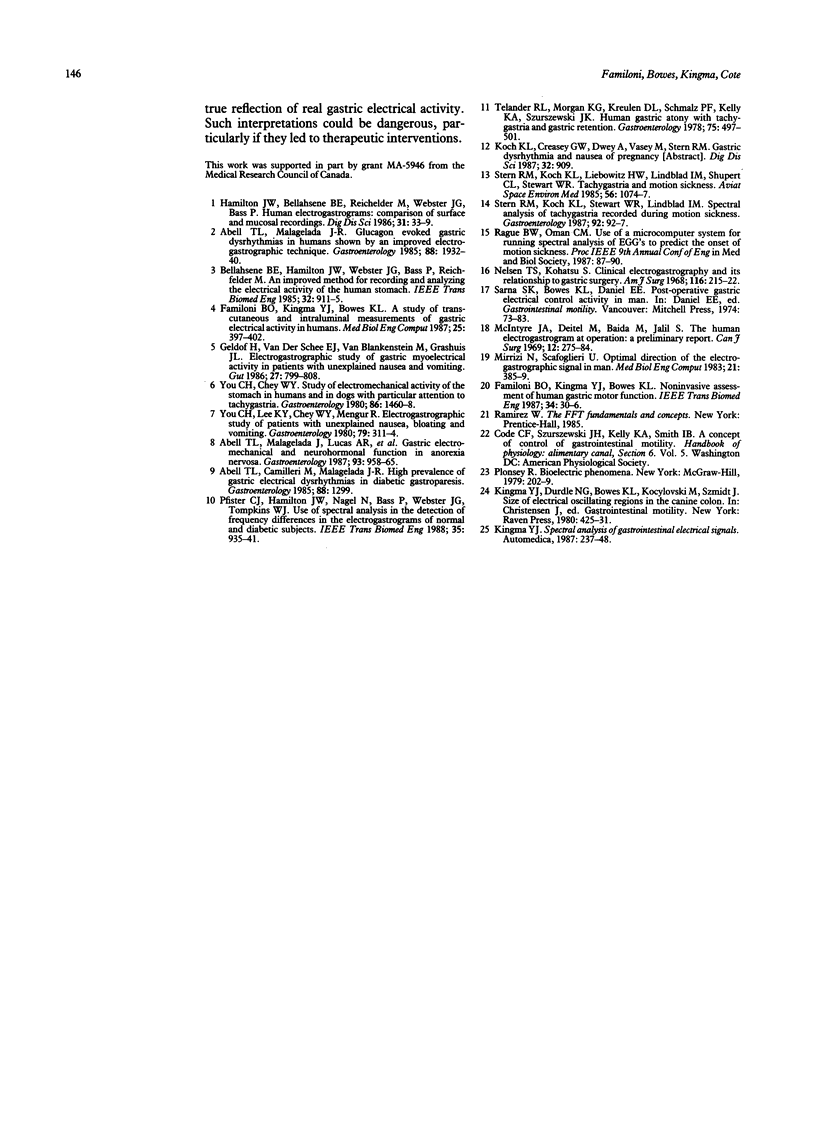
Selected References
These references are in PubMed. This may not be the complete list of references from this article.
- Abell T. L., Malagelada J. R. Glucagon-evoked gastric dysrhythmias in humans shown by an improved electrogastrographic technique. Gastroenterology. 1985 Jun;88(6):1932–1940. doi: 10.1016/0016-5085(85)90022-8. [DOI] [PubMed] [Google Scholar]
- Abell T. L., Malagelada J. R., Lucas A. R., Brown M. L., Camilleri M., Go V. L., Azpiroz F., Callaway C. W., Kao P. C., Zinsmeister A. R. Gastric electromechanical and neurohormonal function in anorexia nervosa. Gastroenterology. 1987 Nov;93(5):958–965. doi: 10.1016/0016-5085(87)90557-9. [DOI] [PubMed] [Google Scholar]
- Abstracts of papers submitted to the American Gastroenterological Association. 86th annual meeting, May 11-17, 1985, New York. Gastroenterology. 1985 May;88(5 Pt 2):1299–1644. doi: 10.1016/S0016-5085(85)80117-7. [DOI] [PMC free article] [PubMed] [Google Scholar]
- Bellahsene B. E., Hamilton J. W., Webster J. G., Bass P., Reichelderfer M. An improved method for recording and analyzing the electrical activity of the human stomach. IEEE Trans Biomed Eng. 1985 Nov;32(11):911–915. doi: 10.1109/TBME.1985.325623. [DOI] [PubMed] [Google Scholar]
- Familoni B. O., Kingma Y. J., Bowes K. L. Noninvasive assessment of human gastric motor function. IEEE Trans Biomed Eng. 1987 Jan;34(1):30–36. doi: 10.1109/tbme.1987.326012. [DOI] [PubMed] [Google Scholar]
- Familoni B. O., Kingma Y. J., Bowes K. L. Study of transcutaneous and intraluminal measurement of gastric electrical activity in humans. Med Biol Eng Comput. 1987 Jul;25(4):397–402. doi: 10.1007/BF02443360. [DOI] [PubMed] [Google Scholar]
- Geldof H., van der Schee E. J., van Blankenstein M., Grashuis J. L. Electrogastrographic study of gastric myoelectrical activity in patients with unexplained nausea and vomiting. Gut. 1986 Jul;27(7):799–808. doi: 10.1136/gut.27.7.799. [DOI] [PMC free article] [PubMed] [Google Scholar]
- Hamilton J. W., Bellahsene B. E., Reichelderfer M., Webster J. G., Bass P. Human electrogastrograms. Comparison of surface and mucosal recordings. Dig Dis Sci. 1986 Jan;31(1):33–39. doi: 10.1007/BF01347907. [DOI] [PubMed] [Google Scholar]
- Mirizzi N., Scafoglieri U. Optimal direction of the electrogastrographic signal in man. Med Biol Eng Comput. 1983 Jul;21(4):385–389. doi: 10.1007/BF02442624. [DOI] [PubMed] [Google Scholar]
- Nelsen T. S., Kohatsu S. Clinical electrogastrography and its relationship to gastric surgery. Am J Surg. 1968 Aug;116(2):215–222. doi: 10.1016/0002-9610(68)90496-0. [DOI] [PubMed] [Google Scholar]
- Pfister C. J., Hamilton J. W., Nagel N., Bass P., Webster J. G., Tompkins W. J. Use of spectral analysis in the detection of frequency differences in the electrogastrograms of normal and diabetic subjects. IEEE Trans Biomed Eng. 1988 Nov;35(11):935–941. doi: 10.1109/10.8673. [DOI] [PubMed] [Google Scholar]
- Stern R. M., Koch K. L., Leibowitz H. W., Lindblad I. M., Shupert C. L., Stewart W. R. Tachygastria and motion sickness. Aviat Space Environ Med. 1985 Nov;56(11):1074–1077. [PubMed] [Google Scholar]
- Stern R. M., Koch K. L., Stewart W. R., Lindblad I. M. Spectral analysis of tachygastria recorded during motion sickness. Gastroenterology. 1987 Jan;92(1):92–97. doi: 10.1016/0016-5085(87)90843-2. [DOI] [PubMed] [Google Scholar]
- Telander R. L., Morgan K. G., Kreulen D. L., Schmalz P. F., Kelly K. A., Szurszewski J. H. Human gastric atony with tachygastria and gastric retention. Gastroenterology. 1978 Sep;75(3):497–501. [PubMed] [Google Scholar]
- You C. H., Chey W. Y. Study of electromechanical activity of the stomach in humans and in dogs with particular attention to tachygastria. Gastroenterology. 1984 Jun;86(6):1460–1468. [PubMed] [Google Scholar]
- You C. H., Lee K. Y., Chey W. Y., Menguy R. Electrogastrographic study of patients with unexplained nausea, bloating, and vomiting. Gastroenterology. 1980 Aug;79(2):311–314. [PubMed] [Google Scholar]


